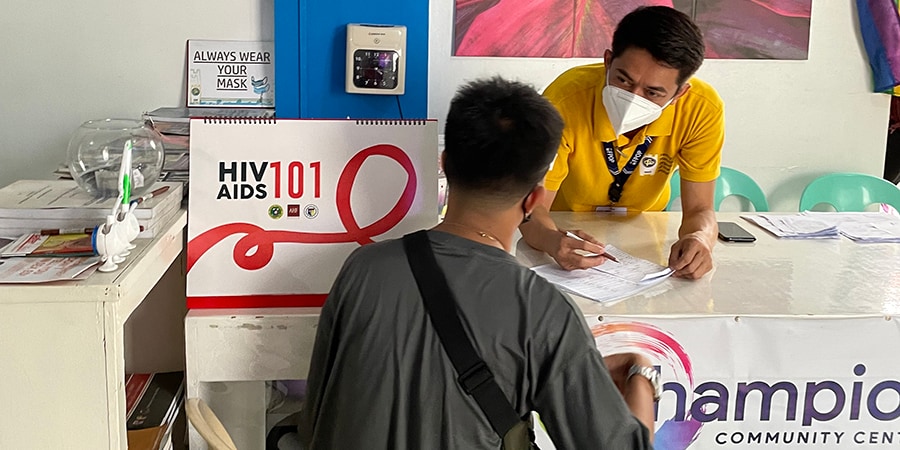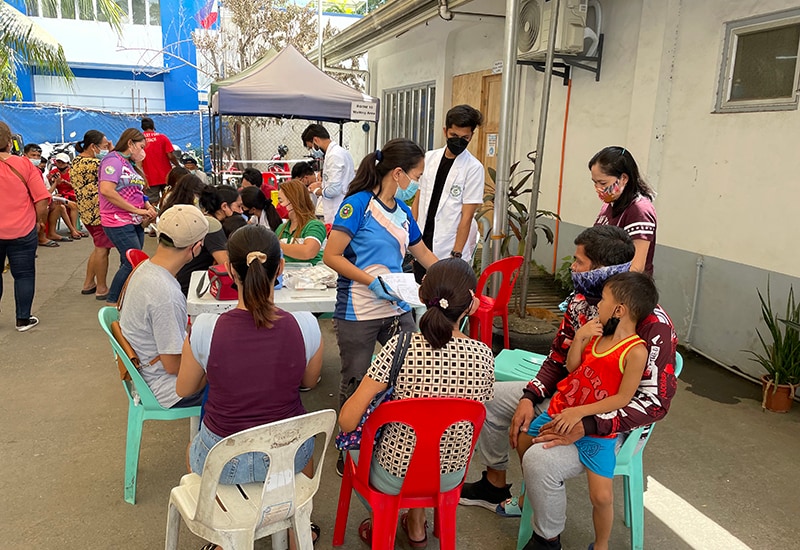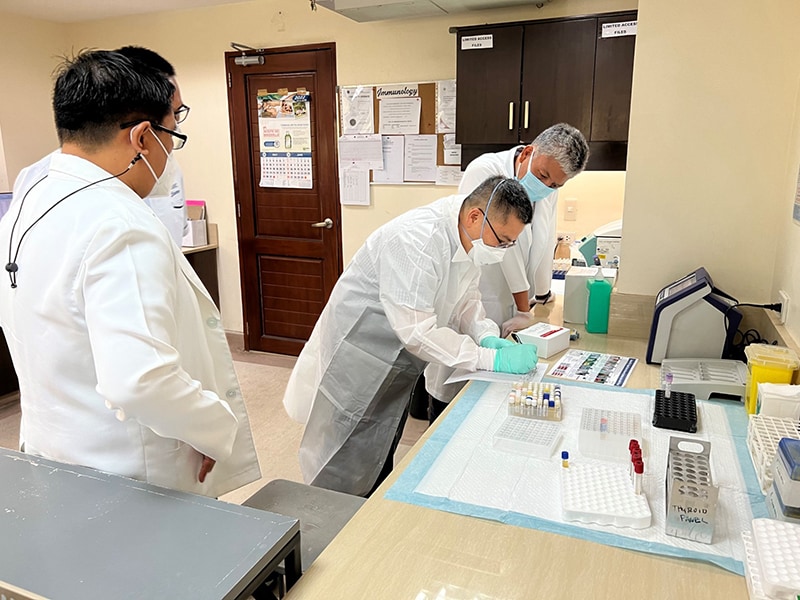CDC in Philippines

A health worker engages with a patient at a CDC-supported HIV testing and treatment center in Iloilo City, Philippines. Photo by Janette Yu-Shears/CDC
The Centers for Disease Control and Prevention (CDC) established an office in the Philippines in 2022 to strengthen and expand existing partnerships with the Philippines Department of Health (DOH). CDC supports the DOH to advance a broad range of health priorities, including increased global health security in Asia. CDC partners with the government of the Philippines and local organizations to prevent and control communicable and non-communicable diseases, strengthen public health emergency preparedness and response, and expand global health security capacity.
HIV/AIDS
The Philippines is experiencing the fastest growing HIV epidemic in the Asia and Pacific region, with a sevenfold increase in newly diagnosed cases between 2010 and 2018. Through the U.S. President’s Emergency Plan for AIDS Relief (PEPFAR), CDC focuses on closing gaps in HIV prevention and treatment service delivery. CDC also works through PEPFAR to support policies that strengthen public health surveillance and laboratory systems in regions that are most impacted by HIV. CDC works closely with the Philippines DOH and other partners to ensure that PEPFAR activities are aligned with the Philippines’ national strategies, priorities, and needs. CDC focuses on:
- Scaling-up comprehensive HIV care and treatment services to increase antiretroviral therapy (ART) coverage and patients’ understanding of treatment guidelines
- Strengthening ART monitoring, retention on treatment, and viral suppression, with an emphasis on community engagement and re-engaging people whose treatment was interrupted
- Implementing quality assurance and improvement activities
- Establishing recent infection surveillance within routine HIV testing services
- Improving laboratory services to ensure timely and routine viral load monitoring
- Developing community messages to reduce stigma and promote Undetectable=Untransmittable (U=U). U=U messages emphasizes that HIV treatment is critical for prevention since people with HIV who achieve and maintain viral suppression through ART cannot transmit HIV to sexual partners
- Promoting community-based testing
- Increasing demand for pre-exposure prophylaxis (PrEP)
- Strengthening and expanding implementation of national guidelines, policies, and practices

Health workers engage with community members seeking care at a CDC-supported clinic in Cebu, Philippines. This clinic provides a range of services, including HIV testing, treatment, and counseling. Photo by Janette Yu-Shears/CDC
CDC provides subject matter expertise to strengthen health systems, prevent avoidable outbreaks, detect health threats early, and respond rapidly and effectively when outbreaks occur. CDC’s global health security work in the Philippines focuses on building capacity across four core areas: disease surveillance, laboratory systems, workforce development, and emergency management and response.
In alignment with DOH priorities, CDC partners with a network of healthcare institutions in the Philippines to address infectious disease threats in healthcare facilities. CDC helps develop and implement programs and interventions that prevent, detect, and respond to infectious diseases in healthcare settings, such as COVID-19 variants, traditional healthcare-associated infections (HAIs), and antimicrobial resistance. The immediate goal is to support the country’s COVID-19 pandemic response by investigating COVID-19 variants among people in hospitals to identify and characterize emerging variants. The long-term goal is to ensure that infectious disease threats are identified and contained in healthcare facilities through HAI surveillance and infection prevention and control.

Mervi Detorio of the CDC International Laboratory Branch demonstrates the Asante HIV-1 Rapid Recency Assay at a medical center laboratory in Cebu, Philippines. Photo by Robert A. Domaoal/CDC
COVID-19
The first case of COVID-19 in the Philippines was confirmed in January 2020. CDC provided technical and financial assistance to support the country’s COVID-19 vaccination program implementation, which included activities related to communication, data management, health information systems, COVID-19 vaccine post-introduction evaluation, and increasing vaccine uptake. CDC continues to support the DOH and other implementing partners with COVID-19 vaccination planning to ensure equitable access and delivery, program implementation, and evaluation.
To create sustainable and resource-appropriate SARS-CoV-2 monitoring programs in the Philippines, CDC works with the DOH’s Research Institute for Tropical Medicine and other partners to establish SARS-CoV-2 variant surveillance among healthcare workers. CDC and partners are also developing plans to leverage U.S. Government and Government of the Philippines interests and investments in SARS-CoV-2 variant surveillance. In partnership with the World Health Organization (WHO), CDC is also conducting surveillance for adverse events associated with immunization (AESI).
Tuberculosis (TB)
A quarter of the world’s population – nearly two billion people – are infected with the TB bacteria and approximately 10 million people become ill each year with the disease. Although it is preventable and treatable, TB remains one of the world’s deadliest infectious diseases and is the leading cause of death for people living with HIV. CDC’s PEPFAR program in the Philippines intends to increase the number of people living with HIV who are accessing TB preventive treatment.
Within the United States, 71% of reported TB cases are among non-U.S.–born persons. The Philippines is the country of birth for 12.5% of these cases. In the Philippines, CDC is implementing strategies to reduce the incidence of TB among Filipino migrants and refugees who are on their way to the United States. CDC’s goal is to engage public health officials to develop and implement a system to identify and treat people with active TB or who are at risk of TB infection.
Influenza
Influenza viruses change constantly and require continued vigilance. CDC works with partners to collect and analyze influenza viruses from around the world. CDC plays a major role in year-round surveillance that enables early detection and identification of seasonal influenza viruses, novel influenza viruses with pandemic potential, and outbreaks of severe respiratory illness syndromes. CDC works with the Philippines to:
- Strengthen surveillance and laboratory capacities to prevent, detect, and respond to influenza threats
- Strengthen connections between national institutions, especially National Influenza Centers
- Maintain capacity to share specimens and clinical and epidemiologic data related to influenza circulation
Vaccine-Preventable Diseases
CDC leads the STOP Program in collaboration with the WHO and United Nations Children’s Fund (UNICEF). The STOP Program recruits and trains international public health consultants who strengthen national immunization surveillance programs, support immunization activities, respond to disease outbreaks, and support polio eradication. In 2021, STOP supported a measles vaccination campaign in the Philippines and is currently participating in the development of the Measles Outbreak Strategic Plan.
Rubella vaccination coverage in the Philippines is suboptimal and the true burden of congenital rubella syndrome (CRS) is unknown due to a lack of surveillance. CDC is supporting a study to document the burden of CRS in the Philippines.
Non-Communicable Diseases
Cardiovascular diseases (CVDs), a group of heart and blood vessel disorders, are the leading cause of death worldwide. Early screening, detection, and treatment are critical to preventing the consequences of CVDs. Many low- and middle-income countries, including the Philippines, have limited laboratory capacity and infrastructure to address CVDs. CDC is working with partners to strengthen capabilities in the Philippines to perform point-of-care lipid testing, especially in rural areas with no central laboratory. Point-of-care testing means that lipids (fatty acids that are key indicators of CVDs) can be tested wherever the patient is, which eliminates the need for transportation and storage of blood samples, increases access to testing, and improves health outcomes.
- 2 U.S. Assignees
- 4 Locally Employed
- Population: > 111 million
- Per capita income: $9,040
- Life expectancy: F 76 / M 67 years
- Infant mortality rate: 18/1,000 live births
Sources: World Bank 2021, Philippines; Population Reference Bureau 2021, Philippines